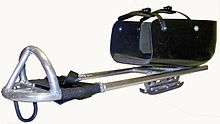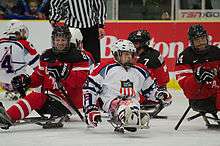Sledge hockey



Sledge hockey (known as sled hockey in the United States) is a sport that was designed to allow participants who have a physical disability to play the game of ice hockey. Ice sledge hockey was invented in the early 1960s in Stockholm, Sweden, at a rehabilitation centre. It is currently one of the most popular sports in the Winter Paralympic Games.[1]
History
Two men from Sweden designed the sledge for ice sledge hockey in the 1960s because they wanted to continue to play hockey despite their physical disability. Their design included two skate blades on a metal frame that allowed the puck to pass underneath. They completed the ensemble by including two round poles with bike handles for sticks. Although there are many restrictions to the measurements and weight of the sledges used in the Paralympic Games, little has changed from the original design to the ones that exist today.
Despite the initial decline of interest after the invention of sledge hockey, competition between sledge hockey teams started up in 1971 that included five teams in Europe. In 1981, Great Britain established their first sledge hockey team, and that was shortly followed by Canada in 1982. It was not until 1990 that the United States developed their first ice sledge hockey team. Sledge hockey continued to expand when Estonia and Japan developed their teams in 1993. International ice sledge hockey became an official event in 1994 for the beginning of the Paralympic Games in Lillehammer, Norway, with Sweden claiming the first gold medal for ice sledge hockey competition. In 1998 the following Paralympic Games in Nagano, Japan, Norway won the gold medal as Canada and Sweden took the silver and bronze respectively. For the 2002 Paralympic Games in Salt Lake City, Utah, USA, the gold medal belonged to the United States with Norway and Sweden finishing second and third. The 2006 Paralympic Games in Torino, Italy, saw the gold medal go to Canada, silver to Norway, and bronze to the United States. In Vancouver, British Columbia, Canada, it was the first time the tournament was competed by mixed teams; teams were permitted to have female athletes on their rosters, previously having been only competed by men.[2]
Rules
Essentially all of the regular ice hockey rules in able-bodied ice hockey leagues apply to ice sledge hockey. The differences are those necessitated by the ice sledge and the athlete. The first set of international rules was created in 1990 and was drafted from Canadian rules. The only rule unique to sledge hockey is Teeing-charging an opponent using any part of the front radius of the sled.[3]
The entrance ways to the players’ benches and penalty benches from the ice are built flush with the playing ice so the players can access them without the help of a coach or able-bodied person. Additionally, the surface area inside the players’ benches and penalty benches are made of smooth plastic or ice, to avoid damage to the players’ sledges.
All players are required to have their ice sledge hockey equipment follow the standard that has been set by HECC (the Hockey Equipment Certification Council Inc.[4]), including their sledges, sticks, helmet, skates (if applicable), and other protective gear. The sticks for ice sledge hockey players have a blade curved at one end in a manner similar to regular ice hockey, and generally six to eight metal teeth at the opposite end of the blade for maneuvering and propulsion. Movement is achieved by using the metal teeth as a means to grip the ice and push oneself forward. The metal teeth cannot be too pointy nor protrude farther than 1 cm beyond the stick, to prevent damage to the ice or injury of other players.

See also
- Ice sledge hockey at the Winter Paralympics
- IPC Ice Sledge Hockey World Championships
- IPC Ice Sledge Hockey European Championships
- British Sledge Hockey Association, the governing body for the sport in the U.K.
- USA Warriors, a sled hockey team consisting of combat-wounded U.S. soldiers
- Power hockey, electric wheelchair hockey
References
- Canadian National Men’s Sledge Hockey Team. (2004). Canadian success in sledge hockey. Retrieved January 27, 2006, from
- Canadian Paralympic Committee. (2006). Torino 2006. Retrieved January 16, 2006, from
- Hockey Alberta. (2004). Sledge hockey tournaments. Retrieved January 16, 2006, from
- International Paralympic Committee. (2006). Ice sledge hockey. Retrieved January 16, 2006, from
- International Paralympic Ice Hockey Rulebook. (2005). International Paralympic Committee. Retrieved January 17, 2006, from
- International Wheelchair Basketball Federation. (2003). Promoting excellence and developing opportunities. Retrieved January 16, 2006, from
- It’s The Real Deal. (2005). Paralympic schools program. Retrieved January 16, 2006, from
- Paralympic Sports Association. (2004). Sledge hockey. Retrieved January 17, 2006, from
- Salt Lake 2002 Paralympics. (2002). Historical records. Retrieved January 16, 2006, from
- Spokes n’ Motion (2006). Retrieved January 16, 2006, from
- CanWin Sports(2006). Retrieved November 20, 2006, from
- Paralympics GB (2009). Retrieved December 23, 2009, from
- http://usawarriorshockey.org/?p=432
- http://video.capitals.nhl.com/videocenter/console?id=186113
Citations
- ↑ "Paralympics unhappy with CTV's plan". Toronto. Archived from the original on March 17, 2010.
- ↑ "Sledge hockey teams can add women for 2010 Games". CTVOlympics.ca. 2009-04-03. Retrieved 2010-02-22.
- ↑ https://www.youtube.com/watch?v=0CWWSNzSVNY
- ↑ "Hockey Equipment Certification Council Inc.". hecc.net. 2010-04-01. Retrieved 2010-04-01.
External links
| Wikimedia Commons has media related to Ice sledge hockey. |